Thinking about adding some small palm trees to your garden? These dwarf palm trees are great for small spaces. They can make your garden look unique.
In this guide, we’ll talk about different types of small palm trees.
You’ll learn about their sizes and how they fit into different climates.
This will help you choose the best palm tree for your garden.
Why Plant Dwarf Palm Trees in Your Garden?
Dwarf palm trees are more than just decorative. They’re practical and versatile, offering year-round greenery in your garden.
Many small palm trees bear fruits, and some even provide materials for oil extraction. Their evergreen nature means your garden stays vibrant through all seasons.
Plus, their compact size makes them a great fit for small spaces, adding a tropical flair without overwhelming your garden layout.
Palm Tree Facts
Did you know that palm trees aren’t just for looks? They’re also a source of useful products. Take coconuts, for instance; they’re a well-known palm product used in various ways, including oil production.
Interestingly, the dwarf palmetto stands out as one of the smallest palm trees, reaching just about 3 feet in height.
Its compact size makes it an excellent choice for front yard landscaping, especially if you’re short on space.
This versatility and functionality make palm trees, particularly the smaller varieties, a smart addition to any garden.
Palm Tree Identification
Identifying palm trees can be fascinating, especially considering their leaf and trunk variations. Typically, their leaves fall into two categories: Pinnate, which are feather-like and elongated, and Palmate, resembling a fan’s spread.
When it comes to trunks, there’s a lot of diversity. While taller palm species often have long, thin trunks, the smaller ones, which we’re focusing on, usually have shorter, fatter trunks.
This characteristic is particularly noticeable in certain dwarf palms, which also feature smooth, slender trunks, giving them a unique, spiky look.
1. Pygmy Date Palm
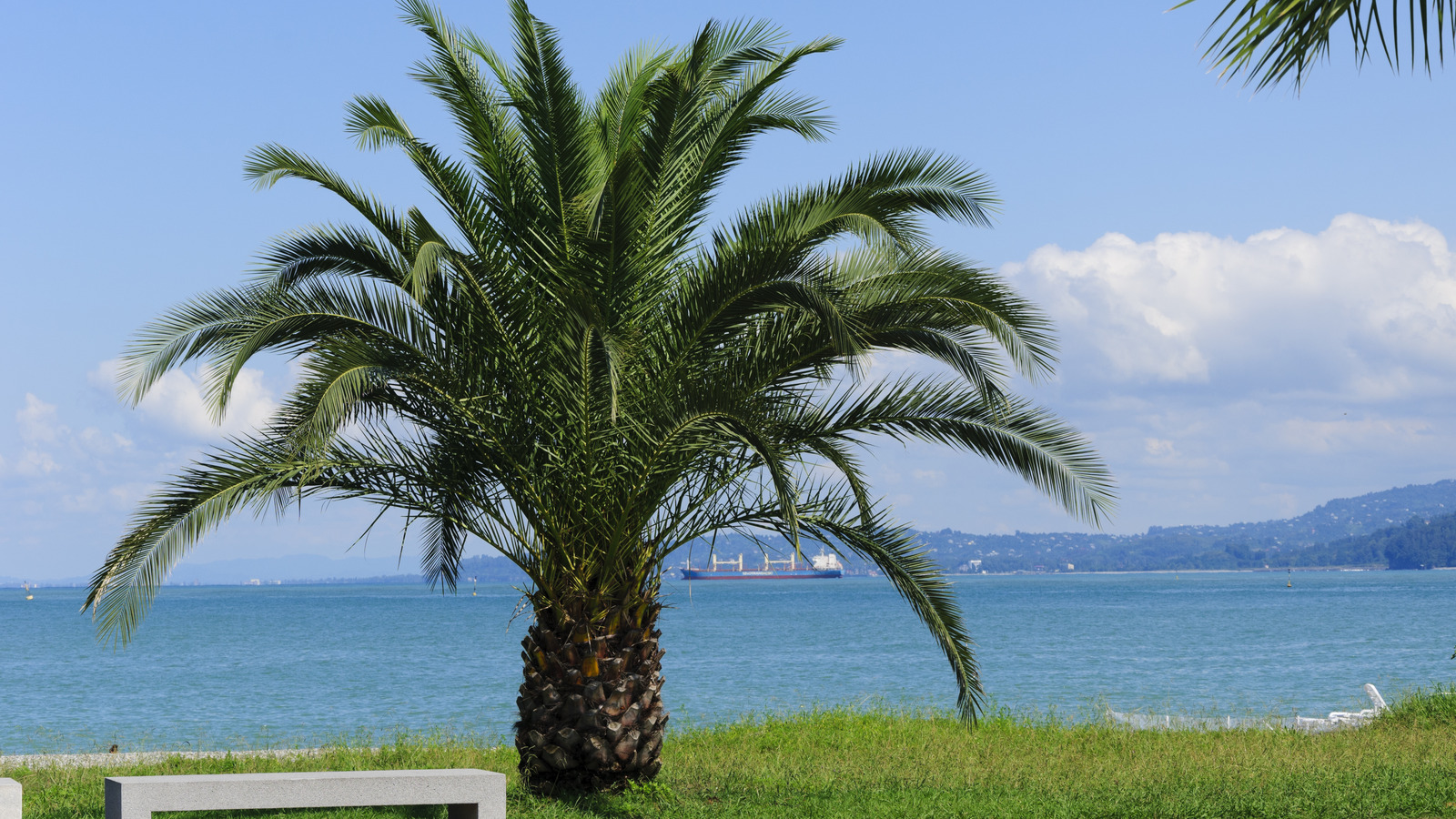
Pygmy Date Palm (Phoenix roebelenii), a standout among short fat palm trees. This member of the Arecaceae family is known for its manageable size, topping out at about 10 feet tall.
The Pygmy Date Palm is perfect for small gardens or as a potted plant on patios. Its single, slender stem supports bushy leaves that can reach up to 3 feet in length, adding a lush, tropical feel to your space.
This palm thrives in USDA hardiness zones 9 to 11, loving the warm subtropical climates. While it enjoys full sun to partial shade, it’s important to provide enough light to maintain its vibrant foliage.
Not just a pretty face, the Pygmy Date Palm also produces small dates. Although these dates aren’t as flavorful as those from larger palms, they add an interesting visual element to the tree.
In terms of care, the Pygmy Date Palm requires well-drained soil and consistent moisture to flourish. It’s relatively low maintenance, making it a great choice for both seasoned gardeners and beginners.
2. Pindo Palm
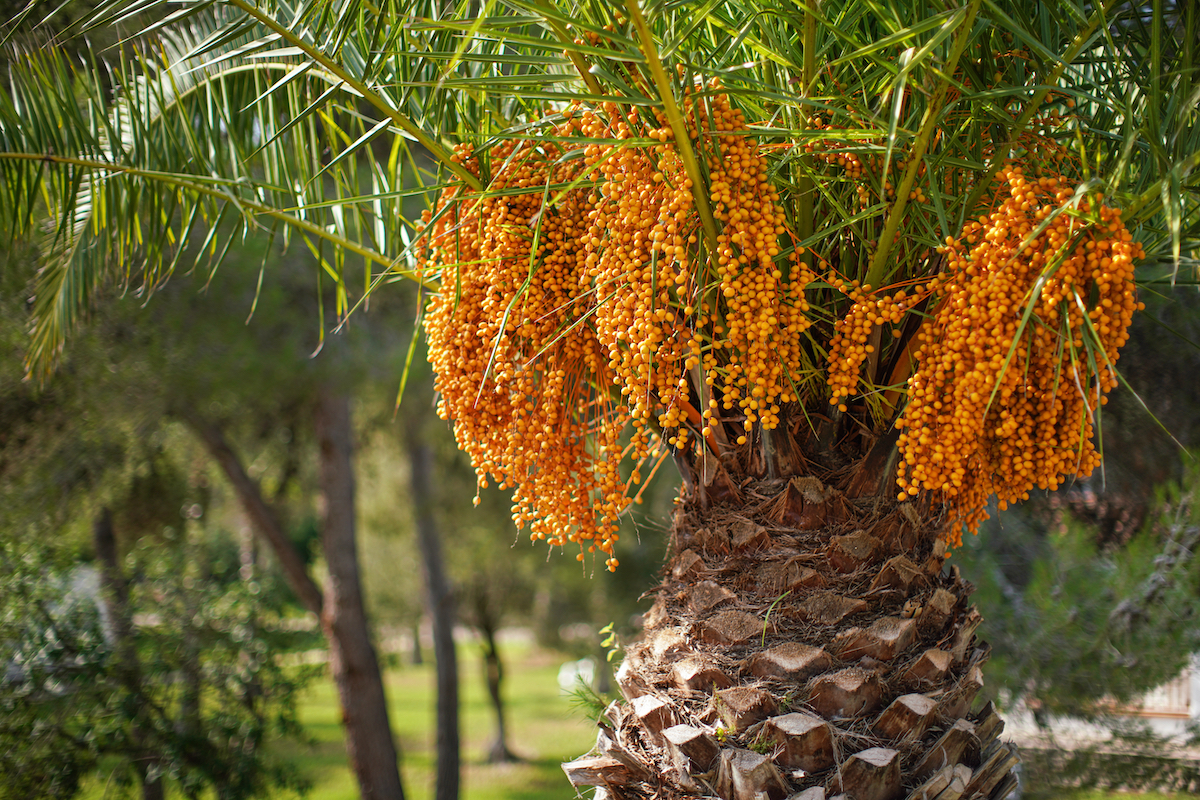
The Pindo Palm, scientifically Butia capitata, is an ideal choice among small palm trees for home gardens.
Recognized for its slow growth rate, this palm reaches heights of 15-20 feet, making it suitable for residential landscapes where space might be limited.
The Pindo Palm is a part of the Cold-Hardy palm species, thriving well in USDA hardiness zones 8-11.
This tree demands ample sunlight, flourishing in full sun to partial shade conditions. It adapts to various soil types, though well-drained soil is preferred for optimal growth.
The unique feature of the Pindo Palm is its light orange to brown fruits, commonly used in making jelly, earning it the nickname “Jelly Palm.”
In addition to its edible fruits, this palm is also admired for its ornamental qualities, showcasing attractive red and yellow flowers that add a splash of color to any garden setting.
Care for the Pindo Palm involves regular watering to establish a deep and extensive root system. Once established, it shows a commendable tolerance to drought, making it a resilient choice for gardens in drier climates.
Its adaptability to different soil types and temperature ranges, combined with its distinctive fruit and flower production, make the Pindo Palm a versatile and appealing option for gardeners looking to add a tropical touch.
3. Triangle Palm
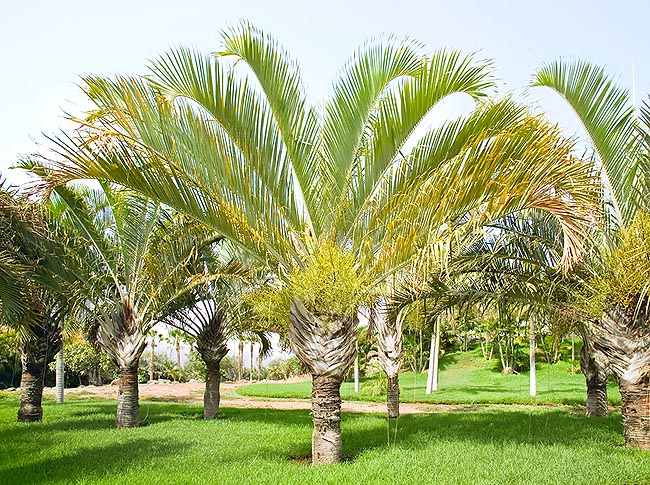
The Triangle Palm, scientifically Dypsis decaryi, stands out in the world of fat palm trees. This palm, known for its distinct triangular shape, reaches up to 8 feet in height, making it an excellent fit for smaller garden spaces.
The tree’s uniqueness lies in its pinnate leaves, which extend from a single trunk and are arranged in a way that they point out at 120 degrees, creating a striking triangular appearance.
Suited for subtropical and tropical gardens, the Triangle Palm thrives best in full sun to partial shade environments, making it a versatile choice for various garden settings.
It’s a hardy species, adaptable to USDA zones 10 to 11. The tree’s long, pinnate leaves not only contribute to its unique geometry but also add an exotic flair to any backyard.
For those seeking to introduce an architectural element with a tropical vibe to their garden, the Triangle Palm is an apt choice.
It requires minimal maintenance and is relatively easy to care for, making it suitable for both novice and experienced gardeners looking to incorporate a touch of the tropics in their outdoor spaces.
Explore our tree service company directory for expert care and maintenance of small or dwarf palm trees, the perfect addition to any garden.
4. Mediterranean Dwarf Palm

The Mediterranean Dwarf Palm, or Chamaerops humilis, is a notable species among short fat palm trees. This palm is characterized by its shrub-like appearance, thanks to several trunks that emerge from its base.
It’s a versatile evergreen, sporting attractive silver-green fan-shaped leaves that maintain a tropical ambiance throughout the year.
Thriving in USDA zones 8 to 11, this palm tree is remarkably temperature-tolerant, making it a resilient choice for various climates. It prefers full sun to partial shade, allowing it to adapt to different light conditions in your garden.
With its ability to reach up to 20 feet, it remains relatively compact compared to other palm species.
The Mediterranean Dwarf Palm is an ideal selection for those who desire a robust, low-maintenance tree that adds a perennial tropical feel to their landscape.
5. Mazari Palm

The Mazari Palm, scientifically termed Nannorrhops ritchiana, stands out in the category of short palm trees due to its striking appearance and cold-hardiness.
This bushy palm is known for its large, fan-shaped leaves that can grow nearly 4 feet in length. The leaves unique silver-blue hue, coupled with their long, tapering ends, give the Mazari Palm a visually appealing, spiky appearance.
Adaptable to a wide range of temperatures, this palm tree is an excellent choice for gardeners in cooler climates, thriving in USDA hardiness zones 6 to 11. Its robust nature makes it a durable addition to landscapes that experience varying weather conditions.
Growing to a mature height of 10 to 20 feet, the Mazari Palm remains manageable for smaller gardens while adding a touch of exotic elegance.
Its striking leaf color and texture make it a focal point in any garden, especially for those looking to incorporate elements of unique natural beauty.
6. Dwarf Majesty Palm
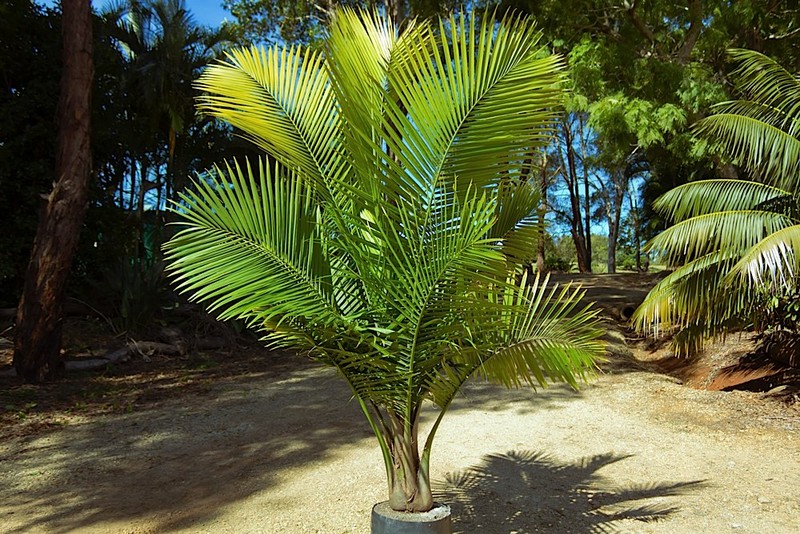
The Dwarf Majesty Palm, scientifically known as Ravenea hildebrandtii, is a highly sought-after variety among fat palm trees. This palm features a sleek, slender trunk, about 3 inches thick, culminating in a height of around 8 feet at maturity.
Its compact size makes it a versatile choice for both indoor and outdoor planting, fitting well in small garden spaces or as an attractive indoor plant.
Adorning this elegant palm are dark green leaves, each stretching up to 3 feet, contributing to more than 100 leaflets on a single stem.
This rich foliage adds a lush, tropical feel to any setting. The Dwarf Majesty Palm thrives best in USDA hardiness zones 9 to 11, preferring environments with full to partial sun exposure.
Ideal for those looking to add a tropical touch to smaller spaces, the Dwarf Majesty Palm is not only aesthetically pleasing but also relatively easy to care for. Regular watering and well-drained soil will ensure its healthy growth.
7. Christmas Palm Tree
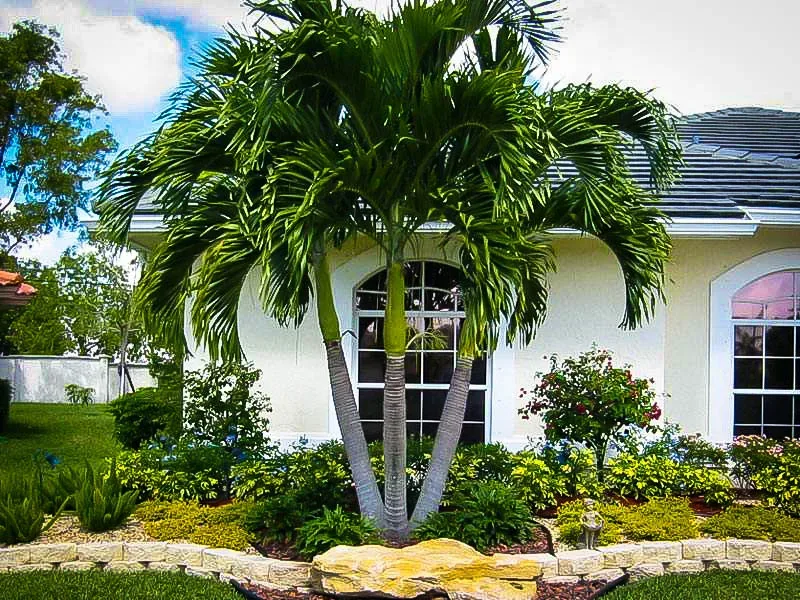
The Christmas Palm Tree, scientifically known as Adonidia merrillii, is a standout among small palm trees, often chosen for its ornamental beauty.
Despite being a type of coconut palm, it is relatively small, with some varieties reaching up to a modest height of 15 feet, making it a suitable choice for gardens where space is limited.
This palm tree is celebrated for its striking green foliage, which emerges in large, lush leaves from the top of its stem.
Its maximum height can reach about 25 feet, but it often stays within the more manageable range of 15 feet, aligning with the theme of short, fat palm trees.
Adonidia merrillii thrives in USDA hardiness zones 10 to 11 and enjoys full sun exposure. Its slender, yet sturdy, trunk supports a crown of large, feathery fronds that create a visually appealing canopy.
This palm is not only a fantastic option for those seeking to add a tropical touch to their garden but also for anyone looking to create a festive, holiday-inspired landscape, given its name and lush appearance.
8. Bottle Palm Tree

The Bottle Palm Tree, or Hyophorbe lagenicaulis, is an intriguing addition to any collection of short fat palm trees.
This species is particularly notable for its distinctive, bottle-shaped trunk, which is thick and swollen at the base, giving the tree its characteristic appearance.
Typically reaching up to 12 feet in height, it is an ideal choice for smaller garden spaces or as a focal point in landscape designs.
This palm tree’s unique structure is not only visually appealing but also serves as an interesting conversation starter.
The Bottle Palm Tree is suitable for USDA hardiness zones 10 to 11, preferring warm climates where it can bask in full sun. The tree’s lush, feathery fronds emerge from the top of the trunk, adding a touch of greenery and tropical flair to your garden.
Given its moderate height and striking form, the Bottle Palm Tree is perfect for gardeners seeking to add an exotic element to their outdoor spaces without overwhelming the area.
9. Dwarf Sugar Palm (Arenga engleri)

The Dwarf Sugar Palm, scientifically known as Arenga anglers, is a superb choice within the category of short-fat palm trees, especially for those looking to enhance their landscaping with a tropical feel.
This palm is multi-stemmed and reaches a modest height of up to 8 feet, making it well-suited for small gardens or as a standout feature in a front yard.
Its bushy, clumping growth habit results in a dense, lush appearance, with vibrant green leaves emerging directly from the ground.
This palm is highly regarded for its landscaping versatility, as it can adapt well to various garden styles, whether in a small backyard or as a striking addition to a front garden.
Thriving in USDA hardiness zones 8 to 11, the Dwarf Sugar Palm prefers full to partial sun exposure.
Its manageable size and bushy form make it an excellent choice for gardeners who are looking for a low-maintenance yet visually appealing palm tree.
10. Saw Palmetto (Serena)

The Saw Palmetto, known scientifically as Serenoa repens, is a unique addition to the short palm trees range. This palm is characterized by its bushy growth and fanning leaves, reaching up to a height of 10 feet.
Its growth habit, where it forms clusters, makes it an excellent choice for creating dense green spaces in gardens or backyards.
This multi-stemmed palm, known for its rugged and natural appearance, is versatile enough to be grown in containers, allowing for flexibility in garden design.
The Saw Palmetto’s ability to thrive in both garden beds and pots makes it a popular choice for adding a dramatic touch to outdoor spaces.
Adaptable to USDA hardiness zones 8 to 11, the Saw Palmetto requires full sun to partial shade to flourish. Its resilience and easy-care nature make it a suitable palm for various landscape settings.
Regular watering and well-drained soil conditions will ensure its healthy growth.
11. Windmill Palm (Trachycarpus Fortunei)

The Windmill Palm, scientifically known as Trachycarpus fortunei, adds a touch of elegance to the selection of short fat palm trees.
Despite its potential to reach up to 20 feet in height, it is often preferred for its robustness and manageable growth, fitting well in most garden sizes.
The palm gets its name from the unique windmill-like arrangement of its fronds, which form an attractive crown at the top of the trunk.
Ideal for adding a striking feature to your backyard or garden, the Windmill Palm is also well-suited for container planting. This flexibility allows you to bring a bit of the tropics to your patio or deck.
It thrives in full sun to partial shade, adapting well to a variety of lighting conditions.
Growing best in USDA hardiness zones 7 to 11, the Windmill Palm is notably cold-hardy, making it a popular choice in regions with cooler climates.
While it can tolerate some shade, ensuring adequate sunlight will help maintain its distinctive form and lush greenery.
12. Sago Palm (Cycas revoluta)
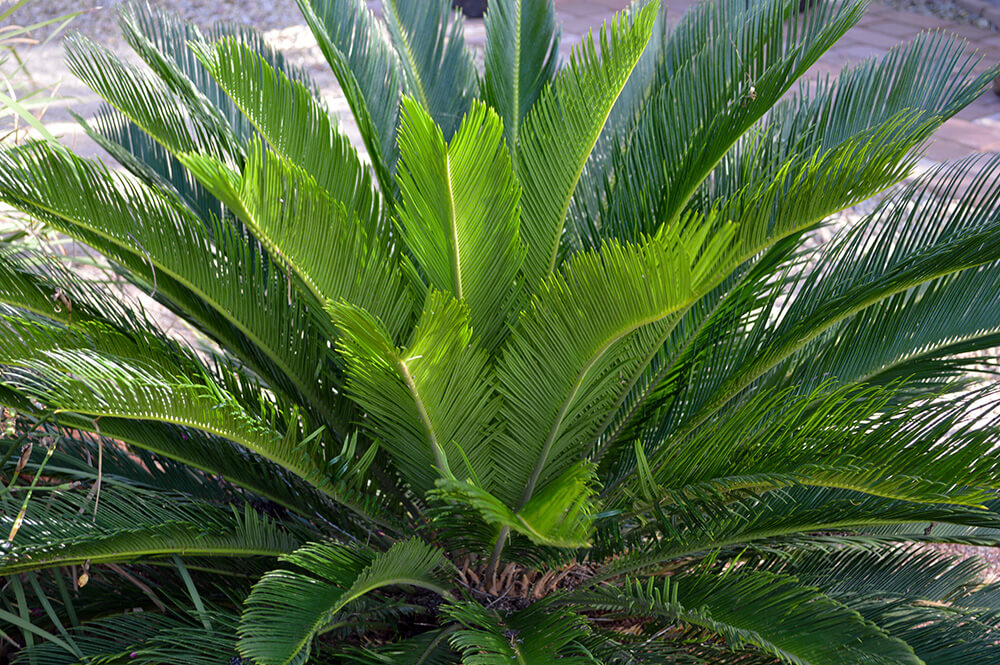
The Sago Palm, botanically Cycas revoluta, is a fascinating addition to gardens, particularly for those interested in short fat palm trees.
Despite its name, it’s actually a cycad, resembling a palm tree in its growth and appearance. Typically, Sago Palms grow to about 20 feet, although they often remain much shorter, making them ideal for compact garden spaces.
This plant is characterized by its textured, shaggy trunk and lush, feather-like leaves that form a beautiful rosette pattern.
It’s particularly noted for its hardiness, capable of withstanding a variety of temperatures, including cold conditions down to 14 degrees F.
This resilience makes it a favored choice in diverse climates, suitable for a range of landscape designs.
The Sago Palm is a superb choice for those seeking an exotic, prehistoric look in their gardens. It thrives in USDA hardiness zones 9 to 11 and prefers full sun to partial shade.
Regular watering and well-drained soil will ensure the Sago Palm maintains its health and distinctive appearance.
13. Needle Palm (Rhapidophyllum Hystrix)
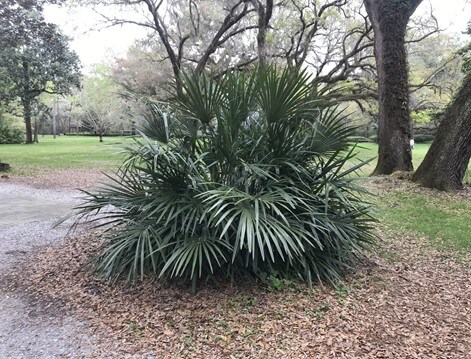
The Needle Palm, scientifically Rhapidophyllum hystrix, is a superb selection for those seeking short fat palm trees for their gardens.
This species stands out with its shrub-like appearance and short, stout trunks that emerge directly from the ground.
It’s particularly notable for its needle-like spikes, which not only lend it a unique look but also contribute to its exceptional cold tolerance, enduring temperatures as low as 5 degrees F.
Growing to a height of around 6 feet and spreading up to 8 feet, the Needle Palm is perfectly suited for smaller landscapes or as an ornamental feature in larger gardens.
Its compact size also makes it ideal for container gardening, allowing for flexibility in placement and design.
This palm thrives in USDA hardiness zones 7 to 11, preferring a spot with partial to full sun exposure. It’s an excellent choice for adding a touch of greenery in colder regions where many other palms may not survive.
14. Cat Palm (Chamaedorea Cataractarum)
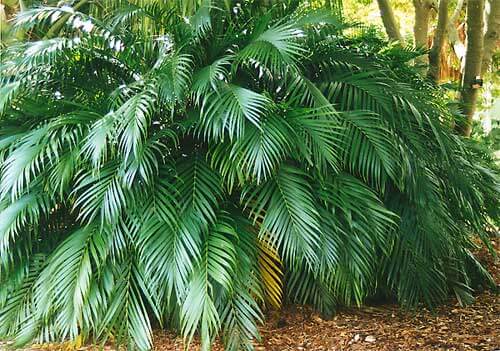
The Cat Palm, known scientifically as Chamaedorea cataractarum, is an ideal choice for those looking for versatile short-fat palm trees.
This palm is characterized by its bushy growth and multiple stems that rise from the ground, creating a dense canopy of dark green leaves.
Growing to a moderate height of about 6.5 feet, it’s perfectly suited for smaller garden spaces or as a lush accent in larger landscapes.
One of the Cat Palm’s notable features is its dense foliage, which makes it an excellent option for creating natural privacy screens in tropical gardens.
Its ability to thrive in bright sunlight and adapt well to container living further enhances its versatility, making it a popular choice for both outdoor and indoor settings.
Suited to USDA hardiness zones 9 to 11, the Cat Palm prefers environments with full to partial sun exposure. Regular watering and well-drained soil are key to maintaining its vibrant appearance.
15. Florida Thatch Palm (Thrinax Radiata)

The Florida Thatch Palm, or Thrinax radiata, is another attractive choice among short-fat palm trees, especially popular in warmer climates.
This palm is known for its slender stem, which culminates in a beautiful canopy of leaves at the top.
Typically, the Florida Thatch Palm reaches a height of up to 20 feet, making it a suitable choice for both small and medium-sized garden spaces.
This palm’s elegant canopy provides a graceful and tropical aesthetic to any garden. It’s well-suited to USDA hardiness zones 10 to 11, thriving in full sun exposure.
The Florida Thatch Palm’s preference for well-drained soil makes it a great candidate for a variety of garden types, including coastal areas where it can tolerate salt spray.
16. Triangle Palm Tree

The Triangle Palm Tree, scientifically known as Dypsis decaryi, is a unique specimen within the variety of short fat palm trees.
This palm is immediately recognizable by its triangular shape, formed by leaves that sprout directly from its notably short trunk. The triangular arrangement of the leaves is a distinctive feature that sets it apart in any garden setting.
Growing to a height of up to 8 feet, the Triangle Palm Tree is an evergreen, ensuring year-round visual interest.
Its manageable size makes it an excellent choice for ornamental purposes or as an accent in garden landscapes.
This palm thrives in a variety of conditions and is known for its low-maintenance requirements, making it a practical choice for gardeners of all experience levels.
Ideally suited for USDA hardiness zones 10 to 11, the Triangle Palm Tree performs best in full sun to partial shade.
17. Coontie Palm
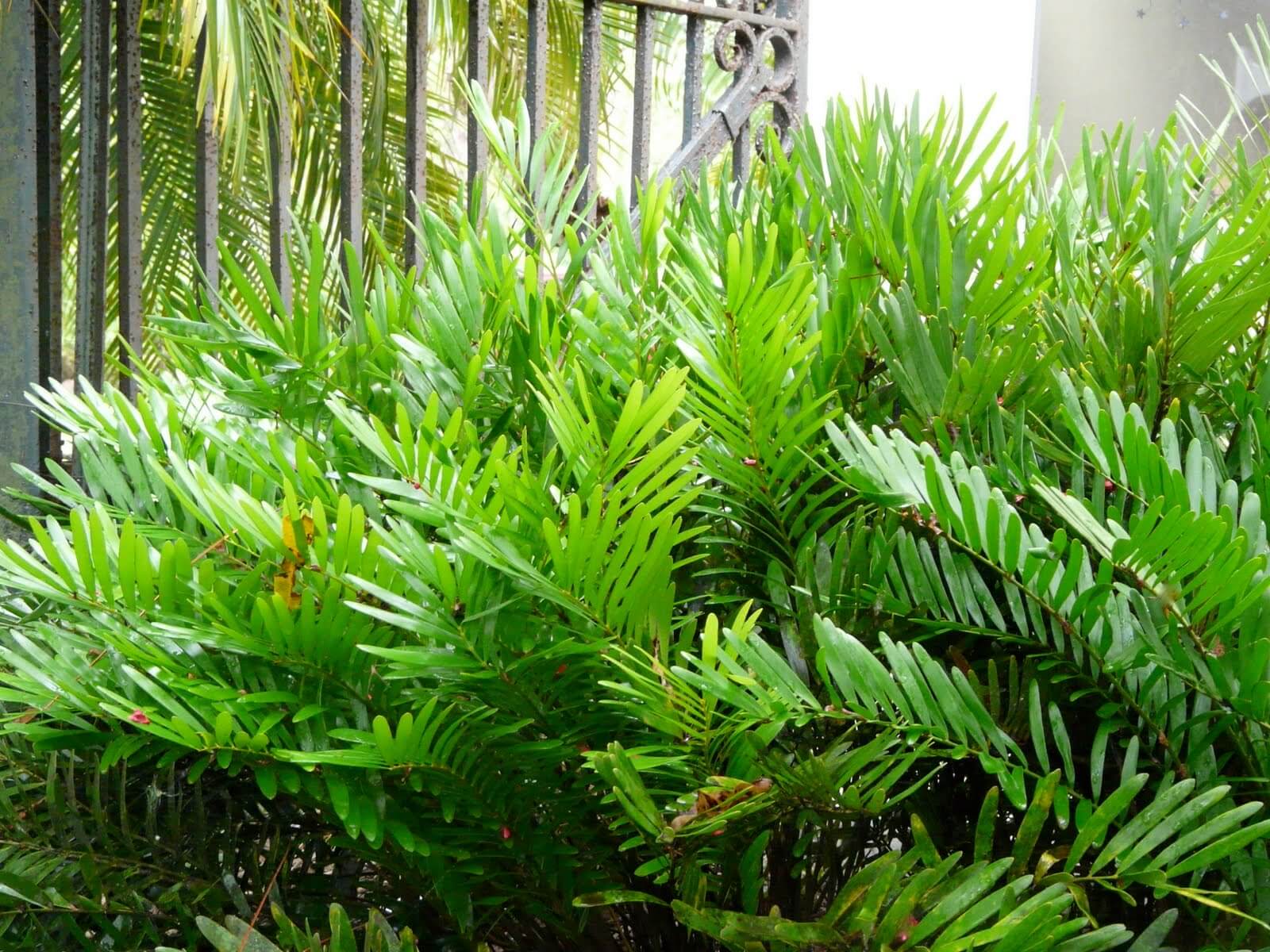
The Coontie Palm, scientifically known as Zamia floridana, adds a unique touch to the collection of short fat palm trees despite being a cycad.
Its palm-like appearance makes it a fascinating addition to any garden. This low-growing plant typically reaches up to 8 feet in height, adopting a bushy, rounded form that resembles more of a shrub than a traditional palm tree.
The Coontie Palm is ideal for use in garden designs that require ground covering or edging, thanks to its compact and bush-like growth habit.
It’s not only visually appealing but also versatile in its landscaping uses.
Adaptable to USDA hardiness zones 8 to 11, the Coontie Palm thrives in full sun to partial shade and is well-suited to a variety of garden settings.
Its tolerance for different soil types and conditions, coupled with its moderate size, makes it a popular choice for gardeners looking for a low-maintenance yet distinctive plant.
Palm Tree Care
Short Palm Trees are very demanding when compared to other houseplants. There are only a few things that you must care about – Light, Soil, Water, Humidity, and Temperature.
- Light: Almost all the different kinds of palm trees thrive in bright light. But you must make sure that the trees do not receive too much direct sunlight as it will result in burning the leaves. You must place the palm tree in such a location where it receives morning and evening sunlight.
- Soil: Soil plays a vital role in the growth of palm trees. A combination of peat moss and leaf mold is ideal for the growth of palm trees. You can also use regular potting soil. You must make sure that the soil you are using drains well and holds some moisture.
- Water: While adding water, you must ensure that you only water your palm when the soil’s top is dried.
- Humidity: Most palm trees require high humidity to thrive because they are evergreen plants. You can use a commercial humidifier for your palm trees to provide enough humidity to them.
- Temperature: Temperature plays an essential role in the growth of palm trees. According to research, average room temperatures are considered ideal for the growth of indoor palm trees.
Final Words
Small palm trees and rare flowers are the best options if you have a small backyard and are thinking of planting a tree. There are various kinds of small and dwarf palm trees that you can choose from.
That is all for this article. We have discussed some of the best small palm trees used in the backyard for ornamental purposes.
We hope you find this article useful, and if you have any queries regarding any palm tree, you can paste them in the comment section below.

![Top 18 Small or Dwarf Palm Trees [with Identification Pictures]](https://cdn.eathappyproject.com/wp-content/uploads/2021/02/Top-18-Small-or-Dwarf-Palm-Trees-with-Identification-Pictures.jpg)
Very informative, where can you purchase any of these small palms. Joanna
I’d like to know aswell,because I would like one too.
Have a small dwarf tree and turning yellow . Is it not enough water or too much. Or does it need trimming.?